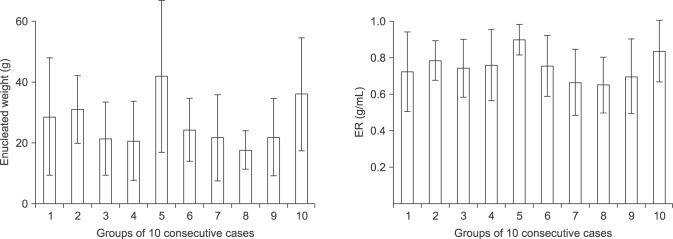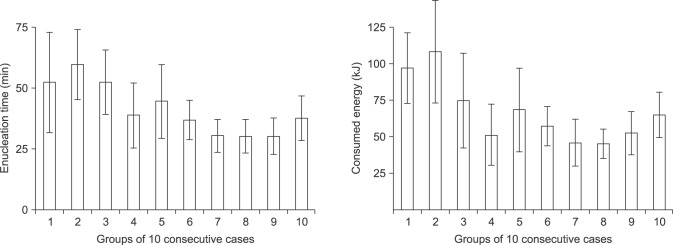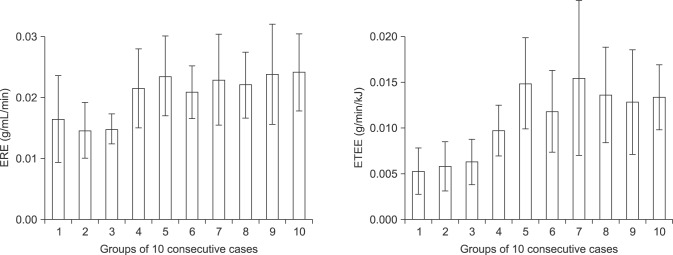World J Mens Health.
2018 Jan;36(1):79-86. 10.5534/wjmh.17039.
Enucleated Weight/Enucleation Time, Is It Appropriate for Estimating Enucleation Skills for Holmium Laser Enucleation of the Prostate? A Consideration of Energy Consumption
- Affiliations
-
- 1Department of Urology, Gachon University Gil Medical Center, Incheon, Korea. uroclinic@naver.com, urohana@gilhospital.com
- KMID: 2399175
- DOI: http://doi.org/10.5534/wjmh.17039
Abstract
- PURPOSE
To date, the parameters for evaluating enucleation efficiency have only considered enucleation time, although operators simultaneously consume both time and energy during holmium laser enucleation of the prostate. This study was undertaken to find a better way of assessing enucleation skills, considering both enucleation time and consumed energy.
MATERIALS AND METHODS
One hundred (n=100) consecutive patients who underwent holmium laser enucleation of the prostate from April 2012 to April 2014 by a single surgeon were enrolled. Ten groups of 10 consecutive cases were used to analyze the parameters of enucleation efficiency.
RESULTS
The mean enucleation time, consumed energy, and enucleated weight were 41.3±19.2 minutes, 66.2±36.0 kJ, and 26.6±21.8 g, respectively. Concerning learning curves, like enucleation time-efficacy (=enucleated weight/enucleation time), enucleation energy-efficacy (=enucleated weight/consumed energy) also had an increasing tendency. Enucleation ratio efficacy (=enucleated weight/transitional zone volume/enucleation time) plateaued after 30 cases. However, enucleation time-energy-efficacy (=enucleated weight/enucleation time/consumed energy) continued to increase after 30 cases and plateaued at 61 to 70 cases. Furthermore, one-way analysis of variance showed that group means for enucleation time-energy-efficacy (F=3.560, p=0.001) were significantly different, but that those of enucleation ratio efficacy (F=1.931, p=0.057) were not.
CONCLUSIONS
When both time and energy were considered, enucleation skills continued to improve even after 30 cases and plateaued at 61 to 70 cases. Therefore, we propose that enucleation time-energy-efficacy should be used as a more appropriate parameter than enucleation ratio efficacy for evaluating enucleation skills.
Figure
Reference
-
1. Piao S, Choo MS, Kim M, Jeon HJ, Oh SJ. Holmium laser enucleation of the prostate is safe for patients above 80 years: a prospective study. Int Neurourol J. 2016; 20:143–150. PMID: 27377947.
Article2. Chilton CP, Mundy IP, Wiseman O. Results of holmium laser resection of the prostate for benign prostatic hyperplasia. J Endourol. 2000; 14:533–534. PMID: 10954312.
Article3. Moody JA, Lingeman JE. Holmium laser enucleation for prostate adenoma greater than 100 gm.: comparison to open prostatectomy. J Urol. 2001; 165:459–462. PMID: 11176396.4. Westenberg A, Gilling P, Kennett K, Frampton C, Fraundorfer M. Holmium laser resection of the prostate versus transurethral resection of the prostate: results of a randomized trial with 4-year minimum long-term followup. J Urol. 2004; 172:616–619. PMID: 15247745.
Article5. Montorsi F, Naspro R, Salonia A, Suardi N, Briganti A, Zanoni M, et al. Holmium laser enucleation versus transurethral resection of the prostate: results from a 2-center, prospective, randomized trial in patients with obstructive benign prostatic hyperplasia. J Urol. 2004; 172:1926–1929. PMID: 15540757.
Article6. Kuntz RM, Lehrich K. Transurethral holmium laser enucleation versus transvesical open enucleation for prostate adenoma greater than 100 gm.: a randomized prospective trial of 120 patients. J Urol. 2002; 168:1465–1469. PMID: 12352419.
Article7. Elzayat EA, Elhilali MM. Holmium laser enucleation of the prostate (HoLEP): the endourologic alternative to open prostatectomy. Eur Urol. 2006; 49:87–91. PMID: 16314033.
Article8. Gilling PJ, Cass CB, Cresswell MD, Fraundorfer MR. Holmium laser resection of the prostate: preliminary results of a new method for the treatment of benign prostatic hyperplasia. Urology. 1996; 47:48–51. PMID: 8560662.
Article9. Gupta N, Sivaramakrishna , Kumar R, Dogra PN, Seth A. Comparison of standard transurethral resection, transurethral vapour resection and holmium laser enucleation of the prostate for managing benign prostatic hyperplasia of >40 g. BJU Int. 2006; 97:85–89. PMID: 16336334.10. Elzayat EA, Elhilali MM. Holmium laser enucleation of the prostate (HoLEP): long-term results, reoperation rate, and possible impact of the learning curve. Eur Urol. 2007; 52:1465–1471. PMID: 17498867.
Article11. Gilling PJ, Mackey M, Cresswell M, Kennett K, Kabalin JN, Fraundorfer MR. Holmium laser versus transurethral resection of the prostate: a randomized prospective trial with 1-year followup. J Urol. 1999; 162:1640–1644. PMID: 10524887.
Article12. Kuntz RM, Lehrich K, Ahyai SA. Holmium laser enucleation of the prostate versus open prostatectomy for prostates greater than 100 grams: 5-year follow-up results of a randomised clinical trial. Eur Urol. 2008; 53:160–166. PMID: 17869409.
Article13. Humphreys MR, Miller NL, Handa SE, Terry C, Munch LC, Lingeman JE. Holmium laser enucleation of the prostate--outcomes independent of prostate size? J Urol. 2008; 180:2431–2435. PMID: 18930490.
Article14. Shah HN, Mahajan AP, Sodha HS, Hegde S, Mohile PD, Bansal MB. Prospective evaluation of the learning curve for holmium laser enucleation of the prostate. J Urol. 2007; 177:1468–1474. PMID: 17382757.
Article15. Seki N, Mochida O, Kinukawa N, Sagiyama K, Naito S. Holmium laser enucleation for prostatic adenoma: analysis of learning curve over the course of 70 consecutive cases. J Urol. 2003; 170:1847–1850. PMID: 14532790.
Article16. Bae J, Oh SJ, Paick JS. The learning curve for holmium laser enucleation of the prostate: a single-center experience. Korean J Urol. 2010; 51:688–693. PMID: 21031088.
Article17. Jeong CW, Oh JK, Cho MC, Bae JB, Oh SJ. Enucleation ratio efficacy might be a better predictor to assess learning curve of holmium laser enucleation of the prostate. Int Braz J Urol. 2012; 38:362–371. PMID: 22765867.
Article18. Gilling PJ, Kennett K, Das AK, Thompson D, Fraundorfer MR. Holmium laser enucleation of the prostate (HoLEP) combined with transurethral tissue morcellation: an update on the early clinical experience. J Endourol. 1998; 12:457–459. PMID: 9847070.
Article19. Arrighi HM, Metter EJ, Guess HA, Fozzard JL. Natural history of benign prostatic hyperplasia and risk of prostatectomy. The baltimore longitudinal study of aging. Urology. 1991; 38:S4–S8.20. AUA Practice. AUA guideline on management of benign prostatic hyperplasia (2003). Chapter 1: Diagnosis and treatment recommendations. J Urol. 2003; 170:530–547. PMID: 12853821.
- Full Text Links
- Actions
-
Cited
- CITED
-
- Close
- Share
- Similar articles
-
- The Learning Curve for Holmium Laser Enucleation of the Prostate: A Single-Center Experience
- Current surgical techniques of enucleation in holmium laser enucleation of the prostate
- Technical Aspects of Holmium Laser Enucleation of the Prostate for Benign Prostatic Hyperplasia
- Von Brunn’s Nest in an Incidental Bladder Mass Found during Holmium Laser Enucleation of the Prostate
- Measuring change in prostate size after holmium laser enucleation: A prospective study





